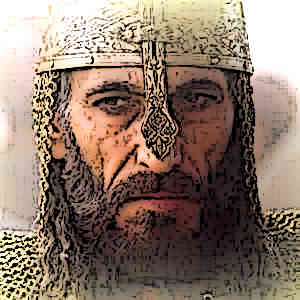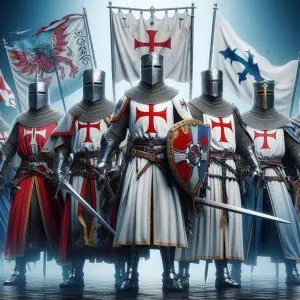The Crusades were a series of intense religious wars fought between Christian and Muslim forces from the late 11th to the 15th centuries. These epic campaigns were not just battles for territory, but also fierce struggles over faith, power, and influence in the Holy Land and beyond. From the successful First Crusade that seized Jerusalem, to the scandalous Fourth Crusade which sacked Constantinople, each major event left a lasting legacy on both European and Middle Eastern history. This list highlights the top 10 defining moments of the Crusades that altered the course of medieval warfare, diplomacy, and religious conflict.

Key Events of The Crusades
1. Battle of Civetot 1096
The Battle of Civetot was fought in 1096.
It was fought between the Seljuk forces of the Sultanate of Rum and the People’s Crusade, which comprised mainly peasants from Christian lands.
This was the first notable armed conflict between Muslim and Christian forces which resulted in a disastrous outcome for the Christian crusaders.
The peoples’ Crusade is also commonly referred to as the peasants’ crusade!

The Seljuk forces were led by Kilij Arslan I. Peter The Hermit was the main Crusader leader but was away in Constantinople at the time. So the crusaders were instead led by Geoffrey Burel.
Seljuks were significantly outnumbered but the Crusader army lacked organization, training, and weaponry.
In total, Seljuks numbered around 5,000 while the Crusaders numbered around 20,000. When the fighting started, the crusaders were quickly routed and a large number died on the battlefield. A few thousand survived.

2. Siege of Antioch 1097
The Siege of Antioch began on October 1097 and ended in June 1098. It was an important event of the Crusades.

Antioch lay on the crusaders’ path to Palestine. The city was strategically located and so, it could be used for supplies and other purposes.
This is why the crusaders decided to seek control of the city and laid siege to it on October 21, 1097.

The siege dragged on for a considerable time. The Muslim forces inside the city led a sortie to engage the crusaders but were defeated and driven back.
Other relief forces under Duqaq of Damascus and Ridwan of Aleppo also attempted to help the Muslim forces inside the city but both were decisively defeated.
In the end, the forces inside the city surrendered and the crusaders achieved a victory.

3. Siege of Jerusalem 1099
The Siege of Jerusalem was the decisive event of the First Crusade.
After achieving several successes in the lands surrounding Jerusalem, the Crusader forces finally converged on Jerusalem and laid siege to the city on June 7, 1099.

Fatimid Caliphate had control of the city at the time. On July 15, 1099, Crusader forces were successful in breaching city walls and forcing an entry.
This led to a successful assault in which Fatimid forces were defeated and most of the city inhabitants put to the sword.

4. Siege of Lisbon 1147
The Siege of Lisbon was one of the very few important events of the Second Crusade.
In this siege, the city of Lisbon was besieged by the Crusaders and Portuguese forces.

The Moorish rulers of the city ultimately agreed to surrender the city in a siege that protracted from July 1147 to October 1147.

5. Siege of Damascus 1148
The Siege of Damascus was another important event during the crusades.
The siege lasted from July 24, 1148, to July 29, 1148. The crusaders marched on the city of Damascus and laid siege to it.
During the siege, the Zengid ruler Nur-ad-Din Zangi came upon the Crusader army with reinforcements and attacked it.
The crusaders were forced to retreat which resulted in a decisive Crusader defeat.

6. Battle of Hattin 1187
The Battle of Hattin was the single most important battlefield event of all the crusades.

It took place after the Second Crusade and just before the Third Crusade.
The battle was fought between the Ayyubid forces of Sultan Salah-ud-din Ayyubi and the Crusader forces with figures like Raynald of Chatillon, Guy of Lusignan, and Gerard de Rideford in it.

It was fought near the horns of a mountain named Hattin for which it is also called the Battle of the Horns of Hattin.
In the battle, Muslim forces used strategic devices to first weaken the Crusader army and then inflicted a crushing defeat on it.

Eminent Crusader leaders were either killed or captured. In the aftermath of the battle, Salah-ud-din also captured Jerusalem.
7. Siege of Jerusalem 1187
The Siege of Jerusalem in 1187 was another key event before the Third Crusade.
It came about directly as a result of the decisive Crusader defeat at the Battle of Hattin.
Salah-ud-din followed his victory by gaining control of several towns and cities, and then marched on to Jerusalem.
He laid siege to the city which lasted from September 20, 1187 to October 2, 1187. In the end, Balian of Ibelin agreed to surrender the city as there were no hopes of relief.
The city was peacefully surrendered and most of its inhabitants allowed to stay or depart alive.

8. Siege of Acre 1189
The Siege of Acre was one of the key events of the Third Crusade. It began in August, 1189 and came to an end in July, 1191. The siege was a counterattack of the Crusader forces after having lost Jerusalem to Saladin.
The siege was a major victory for the Crusaders who were able to secure the surrender of the city and gain control of it. The city then became the new capital of the Kingdom of Jerusalem.

9. Battle of Arsuf
The Battle of Arsuf was fought between the forces of Saladin and Richard the Lionheart (King Richard). It was fought on September 7, 1191.
It resulted in a decisive victory for the Crusaders under Richard so that Saladin’s forces were routed. This ultimately forced Saladin to recognize Crusader control of many coastal regions.

10. Siege of Constantinople 1204
The Siege of Constantinople was an event of the Fourth Crusade.
It took place in April 1204 and resulted in the capture of Constantinople by the Crusader forces. The city was then pillaged and plundered.
The Byzantine Empire itself was broken down into smaller states and divided up between the crusaders.
Although the Empire was restored later, it remained significantly weaker.







